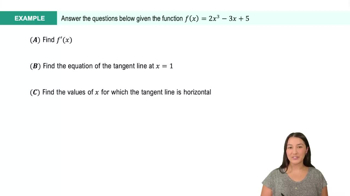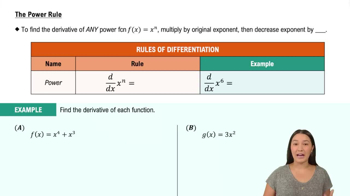Table of contents
- 0. Functions7h 52m
- Introduction to Functions16m
- Piecewise Functions10m
- Properties of Functions9m
- Common Functions1h 8m
- Transformations5m
- Combining Functions27m
- Exponent rules32m
- Exponential Functions28m
- Logarithmic Functions24m
- Properties of Logarithms34m
- Exponential & Logarithmic Equations35m
- Introduction to Trigonometric Functions38m
- Graphs of Trigonometric Functions44m
- Trigonometric Identities47m
- Inverse Trigonometric Functions48m
- 1. Limits and Continuity2h 2m
- 2. Intro to Derivatives1h 33m
- 3. Techniques of Differentiation3h 18m
- 4. Applications of Derivatives2h 38m
- 5. Graphical Applications of Derivatives6h 2m
- 6. Derivatives of Inverse, Exponential, & Logarithmic Functions2h 37m
- 7. Antiderivatives & Indefinite Integrals1h 26m
- 8. Definite Integrals4h 44m
- 9. Graphical Applications of Integrals2h 27m
- 10. Physics Applications of Integrals 2h 22m
3. Techniques of Differentiation
Basic Rules of Differentiation
Problem 3.30
Textbook Question
Derivatives Find the derivative of the following functions. See Example 2 of Section 3.2 for the derivative of √x.
f(s) = √s/4
 Verified step by step guidance
Verified step by step guidance1
Step 1: Rewrite the function f(s) = \frac{\sqrt{s}}{4} in a form that is easier to differentiate. Recall that \sqrt{s} can be expressed as s^{1/2}. Therefore, f(s) = \frac{s^{1/2}}{4}.
Step 2: Apply the constant multiple rule of differentiation. The constant multiple rule states that the derivative of a constant times a function is the constant times the derivative of the function. Here, the constant is \frac{1}{4}. So, we need to find the derivative of s^{1/2} and then multiply it by \frac{1}{4}.
Step 3: Differentiate s^{1/2} using the power rule. The power rule states that if f(x) = x^n, then f'(x) = nx^{n-1}. Applying this to s^{1/2}, we get \frac{1}{2}s^{-1/2}.
Step 4: Multiply the result from Step 3 by the constant \frac{1}{4} from Step 2. This gives us \frac{1}{4} \times \frac{1}{2}s^{-1/2}.
Step 5: Simplify the expression obtained in Step 4. Combine the constants \frac{1}{4} and \frac{1}{2} to get \frac{1}{8}. Therefore, the derivative of f(s) is \frac{1}{8}s^{-1/2}.
 Verified video answer for a similar problem:
Verified video answer for a similar problem:This video solution was recommended by our tutors as helpful for the problem above
Video duration:
4mPlay a video:
Was this helpful?
Key Concepts
Here are the essential concepts you must grasp in order to answer the question correctly.
Derivatives
A derivative represents the rate at which a function changes at any given point. It is defined as the limit of the average rate of change of the function as the interval approaches zero. Derivatives are fundamental in calculus for understanding the behavior of functions, including their slopes and rates of change.
Recommended video:

Derivatives
Power Rule
The Power Rule is a basic differentiation rule used to find the derivative of functions in the form of x^n, where n is a real number. According to this rule, the derivative of x^n is n*x^(n-1). This rule simplifies the process of differentiation, especially for polynomial functions and can be applied to functions involving roots.
Recommended video:
Guided course

Power Rules
Chain Rule
The Chain Rule is a formula for computing the derivative of the composition of two or more functions. It states that if you have a function g(x) that is composed with another function f(x), the derivative is found by multiplying the derivative of the outer function by the derivative of the inner function. This rule is essential for differentiating complex functions, including those involving square roots.
Recommended video:

Intro to the Chain Rule

 3:59m
3:59mWatch next
Master Derivatives of Linear Functions with a bite sized video explanation from Callie
Start learningRelated Videos
Related Practice







